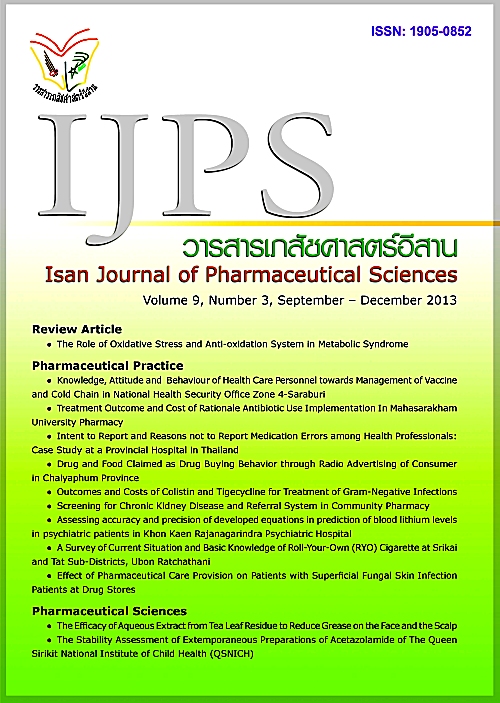Treatment Outcome and Cost of Rationale Antibiotic Use Implementation In Mahasarakham University Pharmacy
Main Article Content
Abstract
Introduction Unnecessary use of antibiotics is cause of antimicrobial resistance. Recently, Antibiotics Smart Use (ASU) was a model to promote the rational use of medicines and counteract antimicrobial resistance. Objective The objectives of this study were to assess the treatment outcome and cost of Antibiotics Smart Use (ASU) guideline for patients with pharyngitis and diarrhea in 3 branches of university pharmacy. Materials and Methods The study design of this study was descriptive. The sample consisted of patients with pharyngitis and diarrhea who attended the service at the university pharmacy during October to December 2012. Patient with pharyngitis were assessed and classified by the McIsacc score. Diarrheal patients were divided into no receiving and receiving antibiotics group. All patients were followed up at 5 days after treatment for pharyngitis and 3 days after treatment for diarrhea. Results Most of pharyngitis patients were classified as 0-1 score (53.8%). Patients who were classified as 2-3 scores who received, did not received antibiotics and ≥4 scores were 10.2%, 29.1% and 2.4%,respectively. Most of diarrheal patients did not receive antibiotics (85.7%). After followed up, patients with pharyngitis had recovered (71.7%); 0-1 score (75.7%), 2-3 scores who received antibiotics (69.2%), 2-3 scores who did not received antibiotics (64.9%) and ≥4 scores(66.7%). The most of diarrheal patients had recovered (95.2%). For pharyngitis, patients with 2-3 scores who received antibiotic and did not receive antibiotic had the highest and lowest of average cost per person, respectively. The patients with 2-3 scores who received antibiotic had the cost per person more than patients with ≥4 scores. The diarrheal patients who received antibiotics had the cost per person more than another group. Overall, satisfaction level of patients was high to very high. Conclusion The results of this study were consistent with antibiotics rational principles of ASU project in hospital. Therefore, the application of this principle in community pharmacies will contribute patients to receive antibiotics appropriately.
Article Details
In the case that some parts are used by others The author must Confirm that obtaining permission to use some of the original authors. And must attach evidence That the permission has been included
References
Apisarnthanarak A, Danchaivijitr S, Khawcharoenporn T, Limsrivilai J, Warachan B, Bailey TC, et al., Effectiveness of Education and an antibiotic-control program in a tertiary care hospital in thailand [Internet]. 2006 [cited 2012 Aug 23]. Available from: http://cid.oxfordjournals.org/
Bureau of drug control, Food and Drug Administration and Faculty of Pharmacy, Srinakharinwirot University. Outcomes of the antibiotics smart use project : a pilot study in Saraburi province; 2008.
Community Pharmacy Association (Thailand). Antibiotic smart use in drug store. All about infection conference 2012; 2012 August 19; Bangkok: Thailand; 2012.
Krittathanmakul S, Sukphet P, Wongprajan P, Makchai P, Jerkwon R, Boriboon S. Developing practice guidelines for common disease in community pharmacy. Songkla Med J 2006;24(3):175-81.
McIsaac WJ, Goel V, To T. The validity of a sore throat score in family practice. CMAJ 2000; 163: 811-5.
Malathum K. Principle of antibiotic using in general practice. In: Sumethkul V, Sungkanuparph S, Kiertiburanakul S, editors. Medical problems in clinical practices. Bangkok: Offset Creation; 2010. P. 498-512.
Martwanna W, Boonjarat S. Pattern of antibiotic used after implementing Antibiotic Smart Use Program [internet]. 2012 June 26 [cited 2012 August 20]. Available from :http://www.knhosp.go.th/Data/June2012/14-06-55/.../Abstract_ASU.pdf
Pongpech P. Antibacterial resistance. In: Kasattut N, Puttilerpong C, editors. Pharmacotherapy infectious diseases 2009. Bangkok: Printing Place; 2009. p. 9-29.
Soompradit N. Antibiotics Smart Use II [internet]. 2009 [September 2009; 2012 July 13]. Available from :http://newsser.fda.moph.go.th/rumthai/userfiledownload/asu121dl.pdf
Thanawuth N, Soorapan S, Rojpitbulstit M, Kasiwong S, Pattharachayakul S, editors. Trends in infectious disease pharmacotherapy. Bangkok: Prachachon Company; 2011.
Thamlikitkul V, Apisitwittaya W. Implementation of clinical practice guidelines for upper respiratory infection in Thailand. International Society for Infectious Diseases.19 November 2003;8(1):4751.
Wongbut K, Wongpud S, Srichom W, Pookpan S. The Evaluation of Prevalence and Antimicrobial Susceptibility of Bacteria Isolated from Client with Upper Respiratory Infection Symptom at Mahasarakham Drug Stores [abstract]. IJPS 2012;8(1):261.


